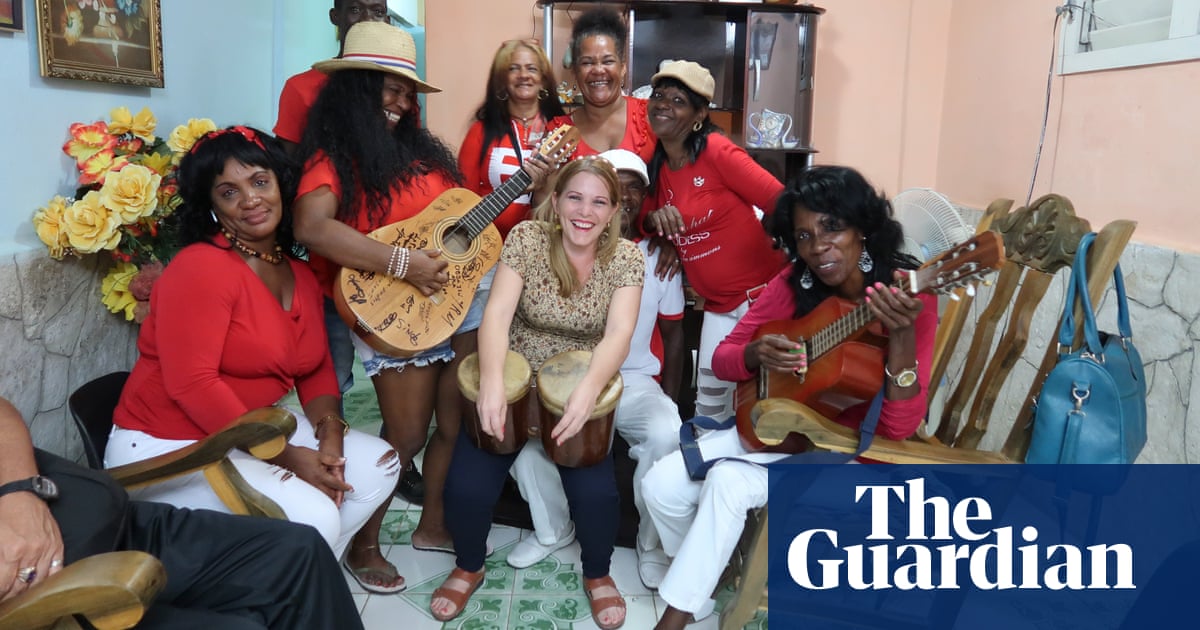World
‘If the world explodes, the only survivors will be cockroaches and Cubans!’: the Guantánamo musicians defying the island’s crisis

It’s 1.30am and the band El Guajiro y su Changüí, led by freestyling lyricist Celso Fernández, are cooking on all burners. They’re onstage at an open-roofed venue in the city of Guantánamo in Cuba – just 20 miles from the infamous US-owned prison in Guantánamo Bay – and playing changüí, the region’s hyperlocal music. Changüí is reportedly a mashup of a Congolese word meaning “jump for joy” and the Guantánamo slang for “party”, and sure enough, this is some of the most exuberant, party-starting music imaginable.
Changüí is not for spectators – anybody can be part of the show. Havana star Elito Revé suddenly jumps on stage and joins in on the scraped-metal guayo and vocals, soon followed by Yarima Blanco, a hotshot on the guitar-like tres. On the first day of the 11th edition of the festival Changüí Elio Revé Matos – named after Elito’s father – these musicians, performing for a nine-judge panel in a competition, are playing changüí the way it’s been done for more than 150 years. For the next three days and nights in late June, the whole city of Guantánamo will come alive with music, and more than 20 mostly local groups will play multiple times a day.
But today’s Guantánamo is very different to the one I left behind in 2019, after spending close to three years recording these groups “in situ” and writing a photo book. The loss of tourism during Covid depleted the island, along with Trump’s 2021 reinstatement of Cuba as a state sponsor of terrorism, which has seriously limited the flow of money in and out.
Though sanctions were slightly eased by Joe Biden in May, Cuba is still deep in crisis. There is no medicine and numerous hospitals have closed. Food is often left in the ground as trucks don’t have enough petrol to deliver it into the cities. The peso is devalued and inflation is rampant – a half kilo of beans costs three days pay or more for most Cubans, including the musicians. Power cuts of between four and 16 hours a day are common (although thankfully not during the festival). More than 4% of the island’s population have left since 2022, including some of the musicians and dancers, and a couple of groups could not make the festival amid worries about there not being enough food to feed them all.
“But we are resilient and we will get through it,” says changüí historian Gabriel Rojas Perez. “If the world explodes, the only survivors will be cockroaches and Cubans.”
Changüí is one of the oldest musical forms in Cuba: a rural, riff-based, call-and-response, largely improvised homegrown dance music that came out of the plantations around the mid- to late-1800s. Rural communities would gather after a week working the plantations to sing and dance from Friday to Monday morning, or even longer on holidays. The music trickled into the city with migrating farmers in the early 1900s. Then, like blues, it spread across the country in the postwar years, after Elio Revé changed up the instrumentation and moved to Havana, seeping it into a lot of Cuban music from Buena Vista Social Club to Los Van Van.
Until the mid-1940s changüí was rural music, with no official groups, until composer and musicologist Rafael Inciarte Brioso cherrypicked the best Guantánamo musicians to form Grupo Changüí de Guantánamo – a version of which still exists today. They are considered the standard-bearers of the urban, slightly faster style that evolved after workers began arriving in cities. Thus traditional changüí was codified into a genre of five instruments: tres, guayo, maracas, bongos and marímbula (an instrument with plucked metal prongs attached to a box).
But away from this metropolitan fusion, in Guantánamo and the surrounding hills it is still played much as it’s always been played. Changüí tells us of communities not in history books; stories are sung and passed from one generation to the next like family heirlooms. “I keep coming to [Guantánamo] because my father was from here,” says Elito, whose own group Elito Revé y su Charangon will be playing nightly outdoor shows. “This is my heritage and I don’t want it to be erased.”
Cuba’s struggles seep into changüí. The prizes for the competition winners at the Changüí Elio Revé Matos festival are now certificates instead of hand-carved wooden statuettes. Some musicians receive salaries from the government but they often receive these wages late, and the usual way of sourcing tres strings – not manufactured on the island – from foreign musicians or returning Cubans has dried up.
But despite the financial and infrastructural difficulties, there’s a determination to celebrate changüí’s legacy, and keep the shows running with barely a pause in the music. The festival always ends with an all-nighter at the Casa del Changüí “Chito” Latamblé, with groups celebrating until 8am Monday morning. “You always know when a changüí starts,” the saying goes, “but not when it ends.”
Late changüí masters are celebrated with a large musical pilgrimage from the centre of town up 15 blocks to the cemetery. The procession marches along, making pit stops to dance and sing as local groups Popó y su Changüí, Grupo Familia Vera and El Moreno y su Changüí play on street corners along the way. “In changüí, we see death not as sadness, but as joy,” says festival organiser José Cuenca, who tirelessly petitioned the government to get the tradition officially recognised as Intangible Cultural Heritage of the Cuban Nation in 2018. “The changuisero may have gone, but their legacy remains. It’s a way of life, an identity, a pride in each person’s spirit and sensibilities. It’s communal joy.”
Another group, Las Flores del Changüí, make a welcome return after bandleader Floridia Hernández experienced health issues brought about by long Covid. Women have always been integral in changüí as musicians, singers and dancers, and as homeowners who regularly opened their doors to three-plus days of non-stop revelry. During a Saturday night street performance, Juana Poulot from Las Flores del Changüí shares the microphone with another bandleader, retired sugar cane worker Alejandro “Popó” Moirán Gamboa, and the pair improvise verses for close to seven minutes.
After the instruments are packed away and the groups leave, members of Eusebia Latamblé y su Changüí – usually helmed by Chito’s Latamblé’s niece who sadly couldn’t make the festival due to health issues – sing and play while passing a cup of rum around. “This is how we do it”, says 78-year-old reveller Rafael Cuesta. “Changüí is a community, we share everything, in good times and in hard times. Changüí is my life.”










